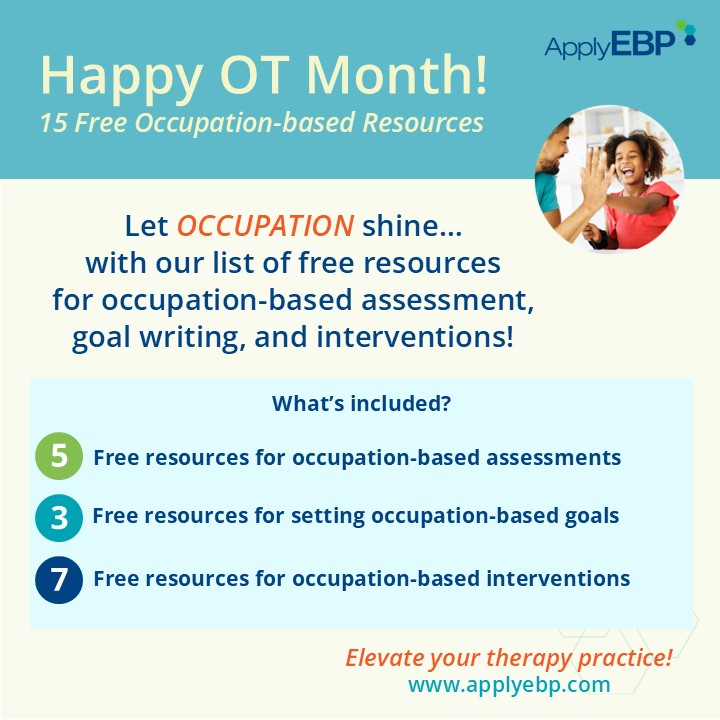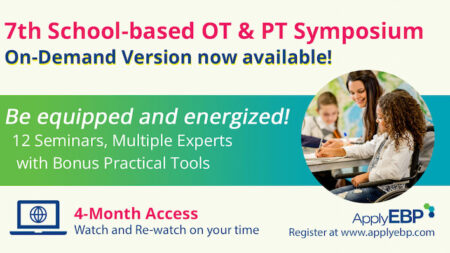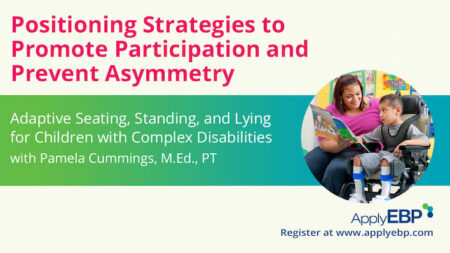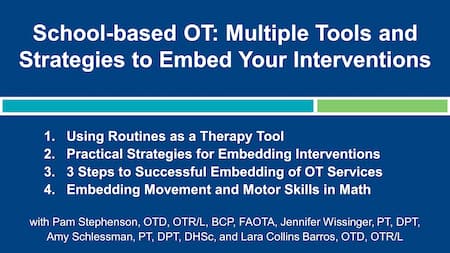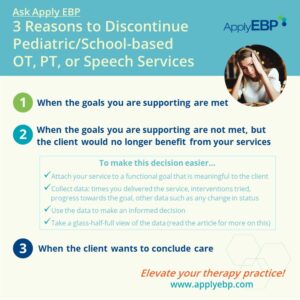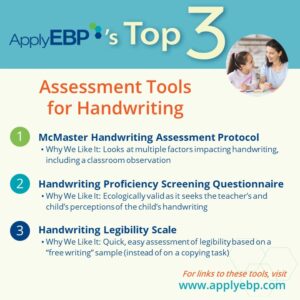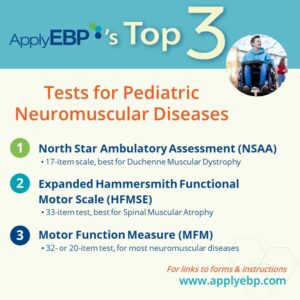Ask Apply EBP
Happy OT Month! 15 Free Resources for Occupation-Based Assessment, Goal Writing, and Interventions
There’s no better time to be an Occupational Therapy Practitioner than now! Multiple research highlights the effectiveness of OT interventions. Better yet, these systematic reviews are showing that the most effective interventions are occupation-based interventions – bringing the profession back to its roots and its name – “Occupation” in Occupational Therapy!
Just to name a couple of these research:
-
-
- In the Occupational Therapy Practice Guidelines for Children and Youth Ages 5–21 Years (2020), Cahill and Beisbier state that “When guided by evidence, activity- and occupation-based interventions are effective in promoting participation and enhancing performance in valued occupations of children and youth ages 5–21 yr.”
- In the article Effectiveness of Paediatric Occupational Therapy for Children with Disabilities: A Systematic Review (2019), Novak and Honan states that “The greatest number of effective green light interventions was at the activity level of the ICF, indicating that daily life skills training using a ‘topdown’ approach is a strength of the occupational therapy profession.”(p.265)
-
Yes, occupation is the way to go! So in this OT Month article, we highlight free resources so we can show what “occupation” means from our assessment to goal setting and interventions!
Occupation-based Assessment Tools
Skuthan and Stav (2024), in their article titled Occupation-Based Assessments in
Pediatric Occupational Therapy Practice, stated that “the use of occupation-based assessments influences the use of occupation in practice” (p. 166). So it’s best practice to use occupation-based assessments. Here are some free resources with our favorite assessment tools for occupation. Note that they usually include the words Occupation or Participation in their names.
1. Top 3 Free Tests for Participation
-
-
-
- Perfect when budget is a concern.
-
-
2. Top 3 For-a-Fee Tests for Participation
-
-
-
- Have some funds? Here are some worth-it assessments to invest on!
-
-
-
-
-
- Activities of Daily Living is an important area of occupation.
-
-
4. 3 Uses of Ecological Assessments, Plus a Free Ecological Assessment Form
-
-
-
- Use your skilled observational skills in any setting with this form.
-
-
5. AOTA Occupational Profile Template
-
-
-
- A template for writing occupational profiles.
-
-
Here are 2 more occupation-based assessment tools we like. They are not free, but they are budget-friendly:
If you would like to learn more about writing occupation-based assessments, take Pam Stephenson’s 3 Components of a Thorough School-based Occupational Therapy Assessments
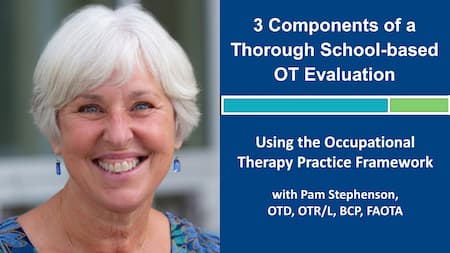
Occupation-based Goals Resources
Here are free resources to get you started with writing occupation-based goals:
6. 4 WH Questions/Elements of Participation-based Goals, Plus a Free Goal Worksheet!
-
-
-
- Be ready to spot the 6 Red Flags to help you identify non-participation or non-occupation-based goals. Then learn the 4 elements that you need to include in the child’s goals to make them participation-based or occupation-based goals.
-
-
7. Strategies to Include Children and Youth in Setting Their Goals
-
-
-
- Vroland-Nordstrand et al (2016) concluded that when included in their own goal setting, children selected goals that “are functional and involve achievements that improve both ADL and interaction with peers in leisure and school tasks.” So one way to ensure your goals are occupation-based is by including children in setting their own goals.
-
-
-
-
-
- Learn the process of creating a less siloed and more student-centered approach to goal writing, with examples.
-
-
Want to learn more about how to write occupation-based goals? Take the Creating Goals that Are Easy to Monitor webinar or attend one of the Creating Goals live workshops with Peggy Morris, OTD, OTR/L, BCP, and Carlo Vialu, PT, MBA
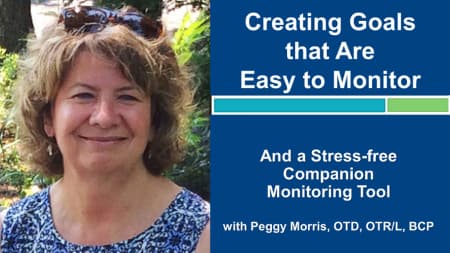
Occupation-based Interventions
Cahill and Beisbier (2020) concluded that “Skills-based training and therapeutic practice in the context of valued occupations are recommended over isolated sensorimotor approaches.” In line with this conclusion, they recommend these interventions:
-
-
- Provide services in the natural environment
- Service delivery models that include peer mediation
- Consistent collaboration with families and caregivers
- “Technology, manualized programs, and sports activities can be effective but should be evaluated and matched to age, diagnosis, and outcomes as guided by the evidence.”
-
Here are some free articles to get you started in providing interventions with fulfilling the 4 elements above:
9. 5 Skilled Services We Can Provide When Embedding in the Student’s Real-life Environment
-
-
-
- Embedding is a great way to “provide services in the natural environment.” However, embedding can be daunting and can seem like unskilled work. Read this article about 5 therapeutic interventions to use when embedding services.
-
-
10. 3 Misconceptions about Assistive Technology (AT), Debunked!
-
-
-
- Assistive technology (AT) is a way to promote instant participation in meaningful occupations. But misconceptions abound, resulting in avoidance of or late introduction of AT. Here’s an article, with accompanying video, to help you and your team support the early use of AT so children with disabilities can meet expectations and participate with their peers.
-
-
11. Top 3 Effective Handwriting Interventions
-
-
-
- Handwriting is an essential school occupation. What’s the best approach to improving handwriting legibility? Grajo, et al (2020) as well as many other authors have concluded that “Therapeutic practice is an evidence-based approach to improve handwriting legibility. In contrast, the evidence indicates that sensorimotor handwriting interventions that address isolated component skills, such as visual perception, kinesthesia, in-hand manipulation, visual–motor integration, or biomechanical features of handwriting, have no effect on handwriting legibility.” Read the free article to find an extensive list of evidence-supported occupation-based strategies for promoting legibility.
-
-
12. Integrated Services for an Inclusive Classroom
-
-
-
- From Susan Bazyk, PhD, OTR/L, FAOTA’s Every Moment Counts, it includes ideas to maximize the impact of related services via integrated services from modifying the environment and/or the task, co-teaching strategies for an inclusive classroom, coaching strategies, small group interventions, and whole-school universal programs
-
-
13. How a Cartwheel Flipped My Practice Right Side Up
-
-
-
- Be inspired by Patti Sharp, OTD, OTR/L, BCP’s evolution from a bottom-up to a top-down (occupation-based) practitioner.
-
-
14. Participating in Chores at Home: A Facilitator of Employment in Youth with Disabilities
-
-
-
- A short checklist to get children and youth involved in chores at home, with chores listed from easiest to most difficult, by Connie Johnson, PT, DScPT, ABPTS-Certified PCS.
-
-
15. Overcoming Obstacles Life Skills Curriculum
-
-
-
- A digital library of life skills activities from Grades K-12.
-
-
We hope that this article filled your therapy toolkit with many occupation-based tools from assessment to goal-writing and interventions. If you want to learn more about occupation-based approaches, take the On-demand Version of the 7th School-based OT and PT Symposium. It includes 12 seminars from multiple school-based/pediatric experts, with multiple tools you can use the very next day!
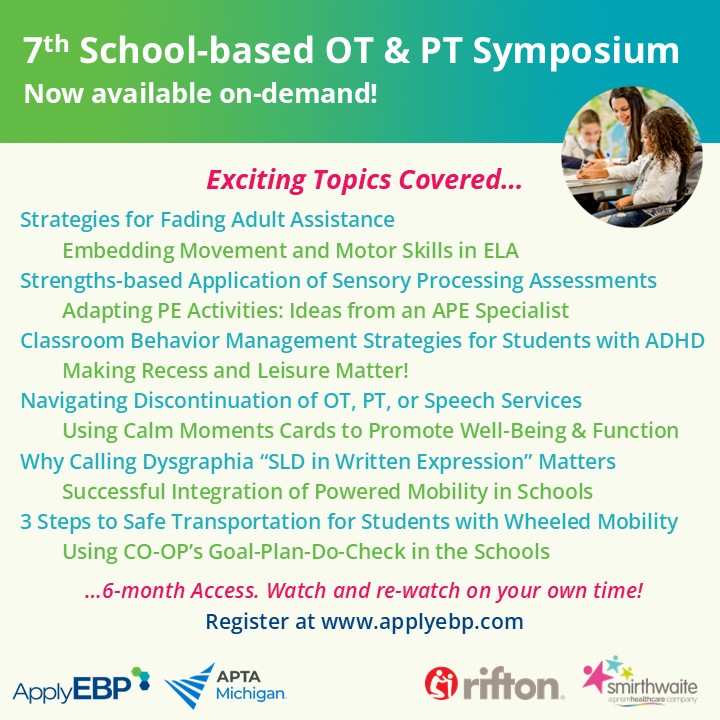
References:
Cahill, S. M., & Beisbier, S. (2020). Occupational therapy practice guidelines for children and youth ages 5–21 years. The American Journal of Occupational Therapy, 74(4), 7404397010p1-7404397010p48.
Grajo, L. C., Candler, C., & Sarafian, A. (2020). Interventions within the scope of occupational therapy to improve children’s academic participation: A systematic review. The American Journal of Occupational Therapy, 74(2), 7402180030p1-7402180030p32.
Novak, I., & Honan, I. (2019). Effectiveness of paediatric occupational therapy for children with disabilities: A systematic review. Australian occupational therapy journal, 66(3), 258-273.
Skuthan, A., & Stav, W. (2024). Occupation-based assessments in pediatric occupational therapy practice. OTJR: Occupational Therapy Journal of Research, 44(2), 159-167.
Skuthan, A., & Stav, W. (2023). Profile of assessments in pediatric occupational therapy practice. The American Journal of Occupational Therapy, 77(5), 7705205010.
Vroland‐Nordstrand, K., Eliasson, A. C., Jacobsson, H., Johansson, U., & Krumlinde‐Sundholm, L. (2016). Can children identify and achieve goals for intervention? A randomized trial comparing two goal‐setting approaches. Developmental Medicine & Child Neurology, 58(6), 589-596.
Find More Answers to Your Questions in Our...
Featured School
Symposium
7th Online School-based OT and PT Symposium - On-Demand Version
- Watch and re-watch on your own time
- On-Demand Version
- OTs, OTAs, PTs and PTAs
- $399-449
Featured Live
Workshop
Deciding Need & Amount of School-based OT/PT
- December 10, 2025, 8:30 am - 3:30 pm Eastern Time
- Online via Zoom
- OTs, OTAs, PTs and PTAs
- $199-259
Positioning Strategies to Promote Participation and Prevent Asymmetry
- Single Topic
Featured On-Demand
Webinar
3 Components of a Thorough School-based OT Evaluation
Featured Webinar
Bundle
School-based OT: Embedded Interventions Bundle
Have a question?
Submit here…
*Clicking submit will send your question directly to our email inbox. Your name and email will let us know that your submission is real (not spam). We will not include these in our posts, unless you tell us to include your name. Please read our privacy policy here.
All infographics and videos on www.applyebp.com are intellectual properties of Apply EBP, LLC
You may use the infographics and videos for free for any non-commercial, educational purposes. Please cite the source as “Apply EBP, LLC” and a link to the source article. If you plan to use any infographic or video for commercial purposes (i.e., for profit), please email Carlo@applyebp.com to obtain a written permission. Permission can be granted on a case-by-case basis.

